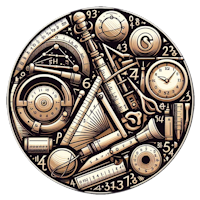
 |
Diophantine EquationsPractise finding integer solutions to equations with more than one unknown. |
This is level 1: linear diophantine equations of the form \(ax+by=c\). You will be awarded a trophy if you get at least 9 answers correct and you do this activity online.
Find a set of positive whole number solutions to the following equations, though there may be more.
InstructionsTry your best to answer the questions above. Type your answers into the boxes provided leaving no spaces. As you work through the exercise regularly click the "check" button. If you have any wrong answers, do your best to do corrections but if there is anything you don't understand, please ask your teacher for help. When you have got all of the questions correct you may want to print out this page and paste it into your exercise book. If you keep your work in an ePortfolio you could take a screen shot of your answers and paste that into your Maths file. |
||
|
|
||

|
More Activities: |
|
|
Mathematicians are not the people who find Maths easy; they are the people who enjoy how mystifying, puzzling and hard it is. Are you a mathematician? Comment recorded on the 6 May 'Starter of the Day' page by Natalie, London: "I am thankful for providing such wonderful starters. They are of immence help and the students enjoy them very much. These starters have saved my time and have made my lessons enjoyable." Comment recorded on the 5 April 'Starter of the Day' page by Mr Stoner, St George's College of Technology: "This resource has made a great deal of difference to the standard of starters for all of our lessons. Thank you for being so creative and imaginative." |
Whose Idea Was This?Did you enjoy doing this 'Diophantine Equations' activity? Are you curious about who originally came up with this idea in Maths? Discover more about one of the mathematicians who is associated with this concept. 
|
|
AnswersThere are answers to this exercise but they are available in this space to teachers, tutors and parents who have logged in to their Transum subscription on this computer. A Transum subscription unlocks the answers to the online exercises, quizzes and puzzles. It also provides the teacher with access to quality external links on each of the Transum Topic pages and the facility to add to the collection themselves. Subscribers can manage class lists, lesson plans and assessment data in the Class Admin application and have access to reports of the Transum Trophies earned by class members. If you would like to enjoy ad-free access to the thousands of Transum resources, receive our monthly newsletter, unlock the printable worksheets and see our Maths Lesson Finishers then sign up for a subscription now: Subscribe |
||
Go MathsLearning and understanding Mathematics, at every level, requires learner engagement. Mathematics is not a spectator sport. Sometimes traditional teaching fails to actively involve students. One way to address the problem is through the use of interactive activities and this web site provides many of those. The Go Maths page is an alphabetical list of free activities designed for students in Secondary/High school. Maths MapAre you looking for something specific? An exercise to supplement the topic you are studying at school at the moment perhaps. Navigate using our Maths Map to find exercises, puzzles and Maths lesson starters grouped by topic. | ||
Teachers | ||
|
If you found this activity useful don't forget to record it in your scheme of work or learning management system. The short URL, ready to be copied and pasted, is as follows: |
Alternatively, if you use Google Classroom, all you have to do is click on the green icon below in order to add this activity to one of your classes. |
It may be worth remembering that if Transum.org should go offline for whatever reason, there is a mirror site at Transum.info that contains most of the resources that are available here on Transum.org. When planning to use technology in your lesson always have a plan B! |
|
|
||
© Transum Mathematics 1997-2025
Scan the QR code below to visit the online version of this activity.
https://www.Transum.org/go/?Num=1097
Close
❎Level 1 - Linear Diophantine equations of the form \(ax+by=c\)
Level 2 - Equations derived from real life situations
Level 3 - Similar to Level 1 but with larger numbers
Level 4 - Non linear Diophantine equations
More on this topic including lesson Starters, visual aids, investigations and self-marking exercises.
A classic example of a Diophantine equation is \(3x + 2y = 11\).
The goal is to find values for \(x\) and \(y\) that are whole numbers (integers) and satisfy this equation.
To solve this, we can start by trying different values for \(x\) and see if we can find a corresponding value for \(y\) that makes the equation true. For example, let's try \(x = 1\):
\(3(1) + 2y = 11\)
\(3 + 2y = 11\)
\(2y = 11 - 3\)
\(2y = 8\)
\(y = \frac{8}{2}\)
\(y = 4\)
So, when \(x = 1\), \(y = 4\). Therefore, one solution to the equation is \(x = 1\) and \(y = 4\).
We can check if there are other solutions by trying different values for \(x\). If we try \(x = 2\):
\(3(2) + 2y = 11\)
\(6 + 2y = 11\)
\(2y = 11 - 6\)
\(2y = 5\)
This doesn't give us an integer solution for \(y\), since 5 divided by 2 is 2.5, not a whole number. Therefore, \(x = 2\) doesn't work.
Similarly, if we try \(x = 3\):
\(3(3) + 2y = 11\)
\(9 + 2y = 11\)
\(2y = 11 - 9\)
\(2y = 2\)
\(y = \frac{2}{2}\)
\(y = 1\)
So, another solution is \(x = 3\) and \(y = 1\).
Therefore, the Diophantine equation \(3x + 2y = 11\) has two positive integer solutions:
\((x, y) = (1, 4)\) and \((x, y) = (3, 1)\).
Don't wait until you have finished the exercise before you click on the 'Check' button. Click it often as you work through the questions to see if you are answering them correctly. You can double-click the 'Check' button to make it float at the bottom of your screen.
Answers to this exercise are available lower down this page when you are logged in to your Transum account. If you don’t yet have a Transum subscription one can be very quickly set up if you are a teacher, tutor or parent.
Close
❎